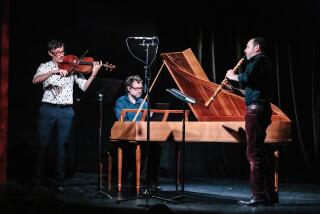Two Views of Satchmo’s Legacy at SFJazz 2001 Opener
SAN FRANCISCO — There was a lively spirit in the air Friday night at Masonic Auditorium when the Spring Season of SFJazz 2001 kicked off the first of six weekends of jazz. Part of the upbeat mood may have been traced to the gift of a glorious blue sky--an early spring day that arrived unexpectedly before an anticipated weekend of rain. But credit should probably also go to the jazz-aware crowd’s expectation of an evening of stimulating music.
Appropriately, the opening weekend’s program was devoted to “The Trumpet” in general, and Louis Armstrong in particular. Anyone who hasn’t spent the last couple of months participating in yet another desert island survivor show is probably aware of the Ken Burns jazz documentary and its rhapsodic adulation of Armstrong. It would be relatively easy, in fact, to assume, after viewing the 10-episode film, that jazz began with Armstrong and became pretty much an academic repertory art after his death.
But the initial concert in SFJazz 2001’s “The Trumpet” weekend--intentionally or unintentionally--offered a perspective on Armstrong and jazz that Burns didn’t quite manage to provide.
The program juxtaposed two dramatically different views of the man usually referred to as “Satchmo” by his listeners and as “Pops” by musicians. The first was offered by trumpeter Randy Sandke’s Armstrong All-Stars, with a front line of Sandke, trombonist Wycliffe Gordon and clarinetist Kenny Davern ripping through a program of Armstrong material.
In some cases--”West End Blues” and “Potato Head Blues” were good examples--the goal was clearly to bring alive as much of the original versions as possible. That process was enhanced by Sandke’s crisp and articulate delivery, as well as his on-the-mark renderings of Armstrong’s original solos. Despite an occasional bop reference from drummer Dave Ratacjak, the essential mission of Sandke’s group--a musically entertaining portrait of early Armstrong--was accomplished with enthusiastic verve.
It was a portrait that largely reflected the entire Burns perspective on Armstrong. But the second part of the program, featuring the Nicholas Payton Louis Armstrong Centennial Celebration ensemble, offered a more expansive Satchmo view.
Rather than assume that jazz was specifically defined--and thereby limited--by Armstrong (and by Ellington, Charlie Parker and Miles Davis), Payton has taken Armstrong material and positioned it within the framework of current jazz practice.
The result was a kind of spirited, musical assertion that jazz is not a museum art, that even the efforts of its earliest practitioners are capable of reexamination and renewal within the context of changing creative eras.
The music, which consists of Payton’s imaginative, often dissonant versions of pieces such as, among numerous others, “Potato Head Blues,” “Peanut Vendor,” “Hold That Tiger” and the Payton original “Dear Louis,” was consistently compelling.
Solos ranged from Payton’s extraordinary trumpet work, rich in New Orleans tradition but unlimited by it, the powerful, avant-garde-tinged tenor saxophone work of Tim Warfield, the hard-swinging trombone of Slide Hampton (a last-minute addition), the propulsive drumming of Adonis Rose and the unerring lead trumpet playing of Paul Stephens. Combined with Payton’s arrangements, they produced vivid, much-needed testimony to the continuing process of growth and creativity that has been part of jazz since Armstrong first appeared on the scene.
Saturday night’s SFJazz 2001 Spring Season program also focused upon Armstrong, in this case via a collection of film clips introduced and described, sometimes in far too great detail, by trumpeter Terence Blanchard. The material ranged from some extraordinary footage from an Armstrong visit to Ghana in 1956 to far less intriguing duets with singer Velma Middleton. Too many of the clips were devoted to playback performances in films, in which Armstrong was obliged to simulate playing and singing to his own prerecorded efforts (a fact that should have been, but was not, noted by Blanchard). Still, there was no denying the value--especially in the live performances--of experiencing Armstrong in action, up close and personal.


